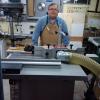
Originally Posted by
mike stenson

Splitters sure, but all the actual riving knives I've seen can be left for non-through cuts.
There are certainly a number of saws out there where the RK has been morphed to hold a guard or pawls and no longer functions like an RK. Kickback danger is reduced by an RK. Cuts that free a keeper or a spoil piece before the RK is engaged can still get launched. There is not universal rule for tablesaw safety. I set my blade height for the operation I am performing. In general I clear the gullet by a bit. For veneers I set the blade higher to adjust the geometry of the tooth path. For joinery operations the blade height is part of the joints profile and is set to the height required for the cut; tenons, rabbets, finger joints, etc.
"A hen is only an egg's way of making another egg".
– Samuel Butler




 Reply With Quote
Reply With Quote








